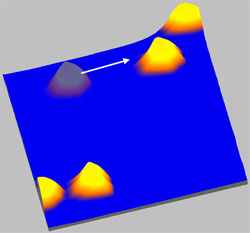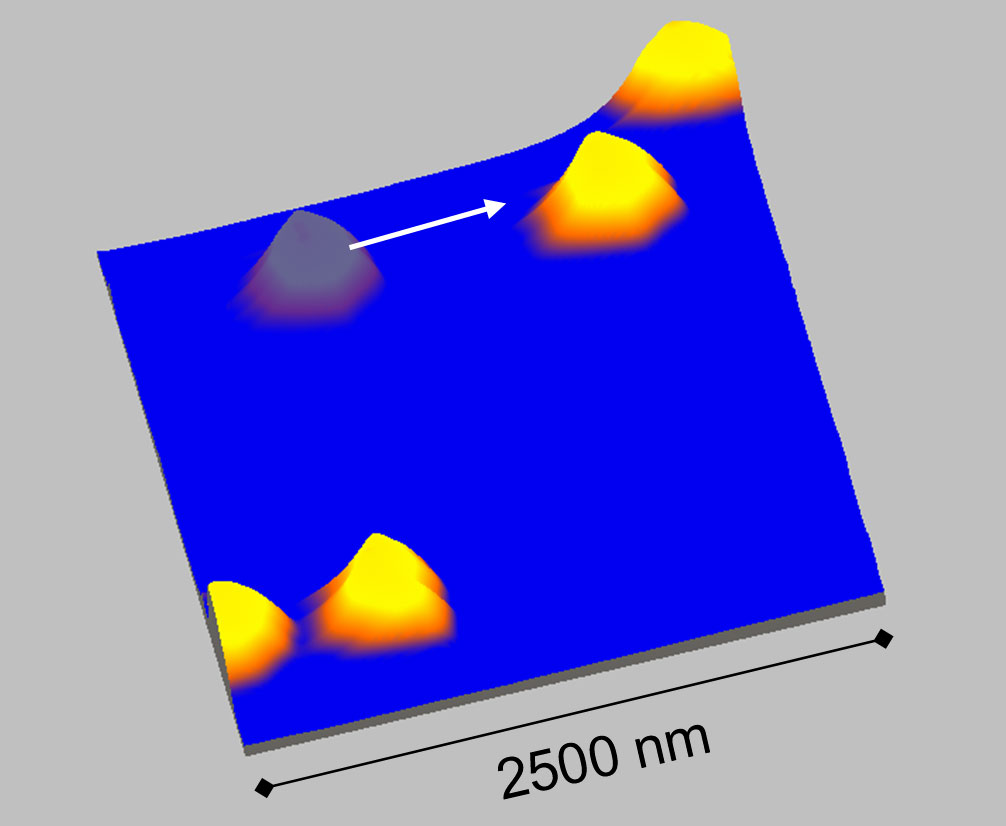To Slide or Not to Slide
It’s no surprise that a block sliding across a table is slowed by friction, but for small enough crystals, theory and a few experiments suggest that frictionless motion may be the norm. Now, in the 19 September Physical Review Letters, a team of researchers pushing nanometer-sized metal blocks across an ultra-clean graphite surface reports that some of them skate freely, while others resist. The results support a theory that friction arises only when extra atoms get trapped between the surfaces. This insight into the origins of friction may be important for researchers developing nanoscale machines that include sliding parts.
When one rough surface slides over another, the bumps in one interlock with the pits of the other. The frictional force is what’s needed to separate the surfaces and keep the sliding motion going. For two perfect, flat crystals, the atoms form the bumps and pits, but unless the crystals match perfectly, the atoms can’t all line up. Theorists maintain that dissimilar crystals should slide past each other with no friction because some atoms will always be attracted into nearby valleys, and that force will help push other atoms out of their valleys. In the past few years, a few experimenters have seen signs of this surprising frictionless motion, or “superlubricity,” as they dragged a super-sharp atomic-force microscope (AFM) tip across a crystal [1].
If superlubricity is the “natural” state for crystal surfaces, why is friction so common? One theory suggests that it arises from extra contaminating molecules, which find their way to the largest gaps and obstruct the sliding motion [2]. Although simulations support this idea, there have been few experimental tests. Indeed, an AFM tip contacts the surface over an area of just a few square nanometers, so the AFM experiments don’t directly apply to larger areas like those in micromachines.
To explore larger areas, André Schirmeisen of the University of Münster, Germany, and his colleagues sprayed atoms of antimony onto an ultra-clean graphite surface, where they formed “islands” as large as 300,000 square nanometers. They then measured the force needed for their AFM tip to push different-sized antimony islands across the graphite surface and were surprised that sometimes it took almost no force at all, Schirmeisen says. “This superlubric behavior was something we were not expecting.” About one island in four skated across the surface in response to an immeasurably small nudge. The other islands needed a much larger, continuous force from the AFM tip, showing the expected behavior for ordinary friction.
Seeing islands with both types of behavior seems to support the theory that friction comes from impurities, says Schirmeisen. “You can’t really tell from the shape” which islands will move without friction. “We think that for some islands there are some ‘dirt’ particles in the interface,” which may even be individual molecules. Indeed, when the researchers exposed their normally ultra-clean samples to ordinary atmosphere, they found far fewer frictionless islands. They also ruled out alternative explanations for the apparent frictionless motion, such as the AFM carrying an island that stuck to it, instead of sliding the island.
“In my view this is the best experimental validation” of the theory that friction on smooth surfaces comes from impurities, says Jay Fineberg of the Hebrew University in Jerusalem. In addition, he says, the island-pushing technique should be useful for exploring friction between materials that can’t be formed into AFM tips.
–Don Monroe
Don Monroe is a freelance science writer in Murray Hill, New Jersey.
References
- M. Dienwiebel, G. S. Verhoeven, N. Pradeep, J. W. M. Frenken, J. A. Heimberg, and H. W. Zandbergen, “Superlubricity of Graphite,” Phys. Rev. Lett. 92, 126101 (2004); A. Socoliuc, R. Bennewitz, E. Gnecco, and E. Meyer, “Transition from Stick-Slip to Continuous Sliding in Atomic Friction: Entering a New Regime of Ultralow Friction,” 92, 134301 (2004); see Focus story describing these experiments suggesting a zero-friction state, J. Minkel, “Reducing Friction without Oil,” Phys. Rev. Focus 13, 14 (2004)
- M. H. Müser, L. Wenning, and M. O. Robbins, “Simple Microscopic Theory of Amontons’s Laws for Static Friction,” Phys. Rev. Lett. 86, 1295 (2001); see Focus story describing this theory of impurity-induced friction, M. Sincell, “Surface Grime Explains Friction,” Phys. Rev. Focus 7, 6 (2001)
More Information
see Focus stories linked above in the references
commentary by Fineberg on a previous version of the paper at the Journal Club for Condensed Matter Physics





